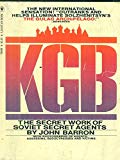
KGB: The Secret Work of the Soviet Secret Agents PDF
Preview KGB: The Secret Work of the Soviet Secret Agents
John Barron's work details the history of the KGB and tradecraft employed running agents in intelligence operations. The KGB is the commonly used acronym for the Russian Komitet gosudarstvennoy bezopasnosti or Committee for State Security. It was the national security agency of the Soviet Union from 1954 until 1991, and was the premier internal security, intelligence, and secret police organization during that time. The The details how it operated legal and illegal espionage residencies in target countries where a legal resident gathered intelligence while based at the Soviet Embassy or Consulate, and, if caught, was protected from prosecution by diplomatic immunity. At best, the compromised spy either returned to the Soviet Union or was declared persona non grata and expelled by the government of the target country. The illegal resident spied, unprotected by diplomatic immunity, and worked independently of Soviet diplomatic and trade missions. In its early history, the KGB valued illegal spies more than legal spies, because illegal spies infiltrated their targets with greater ease. The KGB residency executed four types of espionage: (i) political, (ii) economic, (iii) military-strategic, and (iv) disinformation. The false-identity or legend assumed by a USSR-born illegal spy was elaborate, using the life of either a "live double" (participant to the fabrication) or a "dead double" (whose identity is tailored to the spy). The agent then substantiated his or her legend by living it in a foreign country, before emigrating to the target country, thus the sending of US-bound illegal residents via the Soviet embassy in Ottawa, Canada. Tradecraft included stealing and photographing documents, code-names, contacts, targets, and dead letter boxes, and working as a "friend of the cause" or agents provocateur, who would infiltrate the target group to sow dissension, influence policy, and arrange kidnappings and assassinations.
